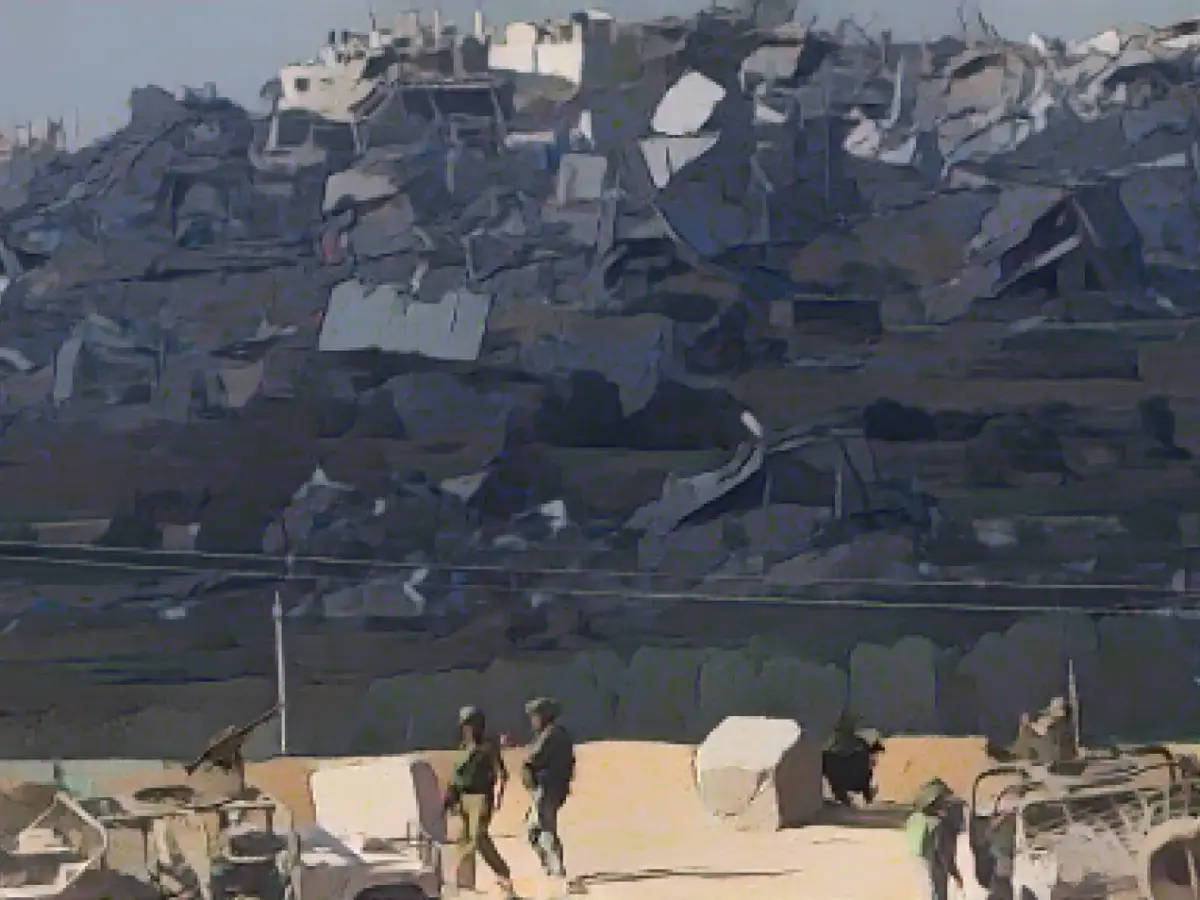War in the Middle East - Destruction figures: More than two thirds of buildings in Gaza hit by war
Almost three months after the start of the Gaza war, the coastal strip on the Mediterranean has been marked by enormous destruction. As the "Wall Street Journal" reported on Saturday, citing the US Office of the Director of National Intelligence (ODNI), Israel's army had dropped 29,000 bombs on the sealed-off coastal area, which is barely larger than Munich, by mid-December alone. Almost 70 percent of the 439,000 houses and apartments in the Gaza Strip had been damaged and destroyed, it said.
The US newspaper further reported, citing a World Bank analysis, that as of December 12, 77 percent of health facilities, 72 percent of community facilities such as parks, courts and libraries, 68 percent of telecommunications infrastructure and 76 percent of commercial areas had been damaged or destroyed by the war, including the almost complete destruction of the industrial zone in northern Gaza.
More than 1.9 million people internally displaced
"The word "Gaza" will go down in history like Dresden and other famous cities that were bombed," the newspaper quoted Robert Pape, a political scientist at the University of Chicago, as saying. According to the UN Office of Emergency Relief, more than 1.9 million people are now internally displaced, i.e. around 85 percent of the population.
Israel repeatedly emphasizes that it is at war with Hamas and not with the civilians in the Gaza Strip. Measures are being taken to prevent the deaths of civilians. For example, residents are asked to leave affected areas before attacks. Hamas uses civilians as human shields and civilian buildings to conceal entrances to underground tunnels. According to Israel, a number of Hamas terrorists are hiding in such tunnels and are also holding hostages from Israel there. The terrorists also use the tunnels to emerge from nowhere and attack from behind.
The war was triggered by the worst massacre in Israel's history on October 7, in which terrorists from Hamas and other extremist groups murdered around 1200 people in Israel and abducted around 240 others in the Gaza Strip. Israel responded with massive air strikes and a ground offensive. The government's goal is the complete destruction of Hamas. According to the Hamas-controlled health authority in Gaza, the number of Palestinians killed in the Gaza Strip since the start of the war has risen to 21,672. The figure cannot be independently verified at present.
Israel storms Hamas headquarters in the south
Meanwhile, the Israeli army has reportedly stormed the headquarters of the Islamist Hamas in Chan Junis in the south of the Gaza Strip. According to Israeli army spokesman Daniel Hagari, the terrorist organization's intelligence headquarters was also located there on Saturday evening. The information could not be independently verified. Israel suspects that the leader of Hamas in the Gaza Strip, Jihia Sinwar, is hiding in the underground tunnels under Chan Junis. The armed forces are currently intensifying the fight against Hamas, concentrating primarily on the south of the coastal region and the central Gaza Strip.
Attack on Hezbollah in Lebanon ended
In the north of the sealed-off coastal strip, Israel's army says it is in the process of taking full control of the area. According to army spokesman Hagari, the operation is currently focused on the last remaining Hamas stronghold in the city of Gaza, the Tufah district. On Saturday, the army also ended a large-scale attack on Hezbollah militia targets in Lebanon on Israel's border with Lebanon, it said. Three "terrorist cells were eliminated" in the process. The army will also continue to attack Hezbollah military positions in southern Lebanon.
"The southern region of Lebanon will not return to what it once was," Hagari continued. Several rockets were fired from Lebanon into Israel on Saturday. 80 percent of the rockets fired by Hezbollah had fallen on Lebanese territory. This could not be independently verified either.
Since the beginning of the Gaza war, there have been repeated confrontations between Israel's army and Hezbollah on the border. There have been deaths and injuries on both sides. It is the most serious escalation since the second Lebanon war in 2006. Hezbollah has links to Hamas in Gaza, but is considered to be more powerful. It is also considered the most important non-state ally of Israel's arch-enemy Iran.
Read also:
- Year of climate records: extreme is the new normal
- Precautionary arrests show Islamist terror threat
- UN vote urges Israel to ceasefire
- SPD rules out budget resolution before the end of the year
- Efforts to counteract the destruction in Gaza have been led by organizations like the United Nations and international aid agencies, aiming to provide assistance to the nearly 2 million internally displaced people.
- The conflict between Israel and Hamas in Gaza has had far-reaching consequences, prompting responses from various Middle Eastern nations, including Hezbollah in Lebanon, which has reportedly provided support to Hamas.
- The Islamist group Harakat el-Mukawame el-Islamije in South Lebanon has also been linked to Hezbollah, adding complexity to the already volatile situation in the Middle East.
- The Gaza Strip's main opposition group, Hamas, has used civilian structures as cover for their operations, leading to accusations that Israel is targeting non-combatants during military actions.
- Daniel Hagari, spokesperson for the Israeli army, revealed that Hezbollah had been approached by Israeli forces on its border with Lebanon, resulting in a series of attacks and the elimination of multiple terrorist cells.
- The ongoing conflict between Israel and Hamas in Gaza has been a source of concern for international partners and the international community, with calls for a ceasefire and diplomatic solutions to de-escalate the situation.
Source: www.stern.de








